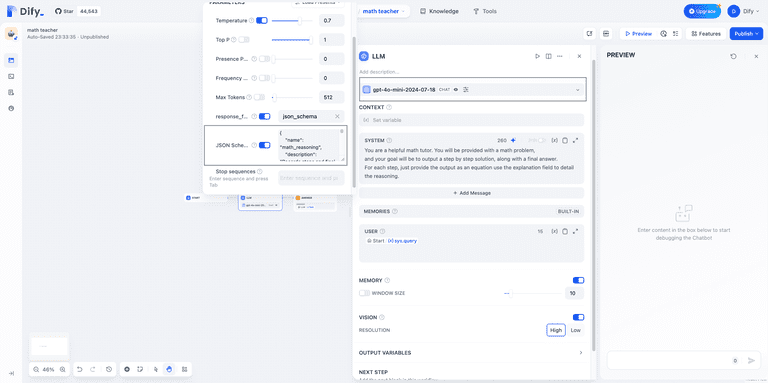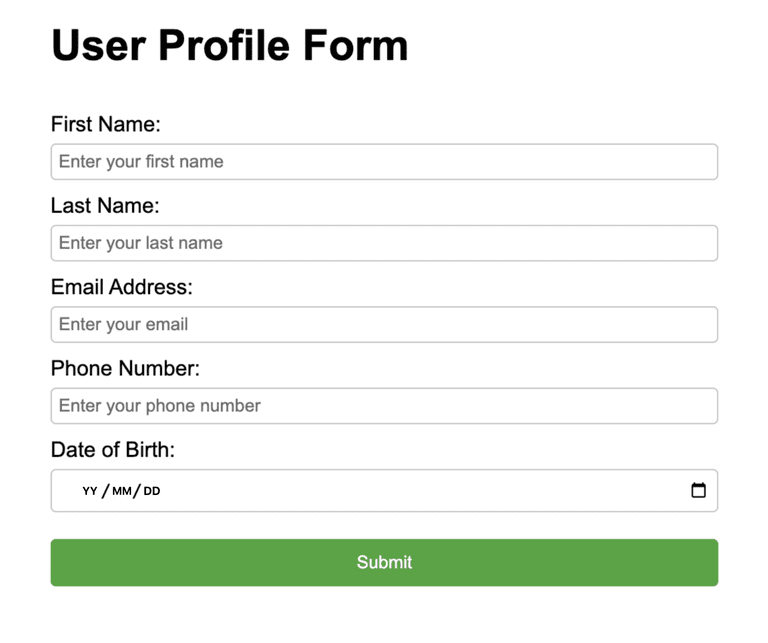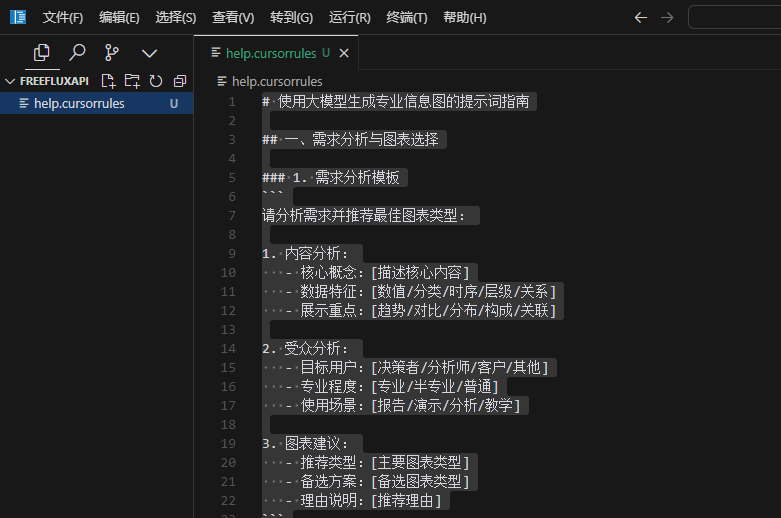JSONArray 基本概念
JSONArray 是一种用于存储多个 JSON 对象的数组结构。每个元素都可以是一个 JSON 对象、数组或基本数据类型(如字符串、数字等)。在 Dify 中,使用 JSONArray 主要涉及到 JSON 数据的解析和生成。
Dify 支持的所有数组结构:String、Number、Boolean、Integer、Object、Array、Enum、anyOf
关系
- JSON Schema 是一种用于描述和验证 JSON 数据格式的规范。它定义了 JSON 数据的结构,包括数据类型、属性、必需字段等。JSON Schema 本身也是一个 JSON 对象,使用特定的关键字来描述数据的组织形式和约束条件。
- JSONArray 是 JSON 数据的一种结构,表示一个有序的值列表。这个列表可以包含多个 JSON 对象、数组或基本数据类型。JSONArray 的格式是用中括号
[]包裹起来的。
验证与描述:JSON Schema 可以用来验证包含 JSONArray 的 JSON 数据。例如,可以在 JSON Schema 中定义一个字段为数组类型,并指定该数组中的每个元素必须是一个特定格式的 JSON 对象。这种方式确保了在处理数据时,JSONArray 中的每个元素都符合预期的结构和类型。
示例:假设我们有一个 JSON 数据如下:
{
"users": [
{"name": "Alice", "age": 30},
{"name": "Bob", "age": 25}
]
}
如果需要在 Dify 中定义一个结构化的 JSON 数据,可以使用 JSON Schema 来描述 JSONArray 的结构。对应的 JSON Schema 可以是:
{
"type": "object",
"properties": {
"users": {
"type": "array",
"items": {
"type": "object",
"properties": {
"name": { "type": "string" },
"age": { "type": "integer" }
},
"required": ["name", "age"]
}
}
},
"required": ["users"]
}
在这个示例中,JSON Schema 明确规定了 users 字段是一个 JSONArray,且其中每个对象都必须包含 name 和 age 属性。
所以问题回到了:如何在 Dify 中使用 JSON Schema 让 LLM 输出遵循结构化格式的内容。
在 Dify 中支持 JSON Schema 功能的模型
o1-2024-12-17and latergpt-4o-mini-2024-07-18and latergpt-4o-2024-08-06and later
如需了解更多关于 OpenAI 系列模型的结构化输出能力,请参考 结构化输出。
注意:json_schema 和 function calling 都可以生成结构化数据。json_schema 仅用于对内容进行结构化数据。function calling 在调用数据、工具、功能时候并生成答案时,更有用。Dify 中”智能助理“关联工具,就是用了 function calling 的方法。
正文:Dify 工具中配置 JSON Schema 结构化输出
以下是指定 LLM 结构化输出的用法路径:
- 将 LLM 连接到系统中的工具、函数、数据等;在函数定义中设置
strict: true,当打开它时,结构化输出(Structured-outputs)功能可确保 LLM 为函数调用生成的参数与你在函数定义中提供的 JSON 架构完全匹配。 - LLM 回答用户时,按照 JSON Schema 中的定义,以结构化内容格式输出。
下文将简要介绍如何在 Dify 开启并使用 JSON Schema 功能。
1. 开启 JSON Schema
将应用中的 LLM 切换至上述支持 JSON Schema 输出的模型,然后在设置表单开启 JSON Schema 并填写 JSON Schema 模板;同时开启 response_format 栏并切换至 json_schema 格式。

LLM 生成的内容支持以下格式输出:
- Text: 以文本格式输出
2. 定义 JSON Schema 模板
你可以参考以下 JSON Schema 格式并定义模板内容:
{
"name":"template_schema",
"description":"A generic template for JSON Schema",
"strict":true,
"schema": {
"type":"object",
"properties": {
"field1": {
"type":"string",
"description":"Description of field1"
},
"field2": {
"type":"number",
"description":"Description of field2"
},
"field3": {
"type":"array",
"description":"Description of field3",
"items": {
"type":"string"
}
},
"field4": {
"type":"object",
"description":"Description of field4",
"properties": {
"subfield1": {
"type":"string",
"description":"Description of subfield1"
}
},
"required": ["subfield1"],
"additionalProperties":false
}
},
"required": ["field1","field2","field3","field4"],
"additionalProperties":false
}
}
步骤指导:
- 定义基本信息:
- 设置
name:为你的 schema 起一个描述性的名称。 - 添加
description:简要说明 schema 的用途。 - 设置
strict: true:确保严格模式。
- 创建
schema对象:
- 设置
type: "object":指定根级别为对象类型。 - 添加
properties对象:用于定义所有字段。
- 定义字段:
- 为每个字段创建一个对象,包含
type和description。 - 常见类型:
string,number,boolean,array,object。 - 对于数组,使用
items定义元素类型。 - 对于对象,递归定义
properties。
- 设置约束:
- 在每个级别添加
required数组,列出所有必需字段。 - 在每个对象级别设置
additionalProperties: false。
- 特殊字段处理:
- 使用
enum限制可选值。 - 使用
$ref实现递归结构。
示例
1. 推理链(常规)
JSON Schema 文件示例
{
"name":"math_reasoning",
"description":"Records steps and final answer for mathematical reasoning",
"strict":true,
"schema": {
"type":"object",
"properties": {
"steps": {
"type":"array",
"description":"Array of reasoning steps",
"items": {
"type":"object",
"properties": {
"explanation": {
"type":"string",
"description":"Explanation of the reasoning step"
},
"output": {
"type":"string",
"description":"Output of the reasoning step"
}
},
"required": ["explanation","output"],
"additionalProperties":false
}
},
"final_answer": {
"type":"string",
"description":"The final answer to the mathematical problem"
}
},
"additionalProperties":false,
"required": ["steps","final_answer"]
}
}
提示词参考
You are a helpful math tutor. You will be provided with a math problem,
and your goal will be to output a step by step solution, along with a final answer.
For each step, just provide the output as an equation use the explanation field to detail the reasoning.
UI 生成器(根递归模式)
{
"name":"ui",
"description":"Dynamically generated UI",
"strict":true,
"schema": {
"type":"object",
"properties": {
"type": {
"type":"string",
"description":"The type of the UI component",
"enum": ["div","button","header","section","field","form"]
},
"label": {
"type":"string",
"description":"The label of the UI component, used for buttons or form fields"
},
"children": {
"type":"array",
"description":"Nested UI components",
"items": {
"$ref":"#"
}
},
"attributes": {
"type":"array",
"description":"Arbitrary attributes for the UI component, suitable for any element",
"items": {
"type":"object",
"properties": {
"name": {
"type":"string",
"description":"The name of the attribute, for example onClick or className"
},
"value": {
"type":"string",
"description":"The value of the attribute"
}
},
"additionalProperties":false,
"required": ["name","value"]
}
}
},
"required": ["type","label","children","attributes"],
"additionalProperties":false
}
}
提示词参考:
You are a UI generator AI. Convert the user input into a UI.
效果示例:

提示
- 请确保应用提示词内包含如何处理用户输入无法产生有效响应的情况说明。
- 模型将始终尝试遵循提供的模式,如果输入的内容与指定的模式完全无关,则可能会导致 LLM 产生幻觉。
- 如果 LLM 检测到输入与任务不兼容,你可以在提示中包含语言,以指定返回空参数或特定句子。
- 所有字段必须为
required,详情请参考此处。 - additionalProperties:false 必须始终在对象中设置
- 模式的根级别对象必须是一个对象
- 大模型结构化数据输出方法:精选 LLM JSON 资源列表
© 版权声明
文章版权归 AI分享圈 所有,未经允许请勿转载。
相关文章

暂无评论...




